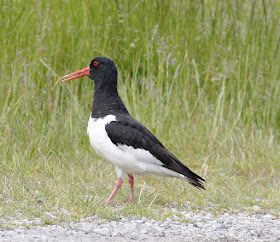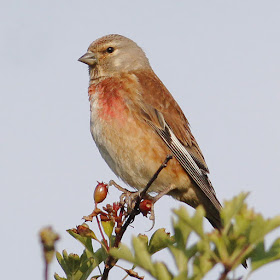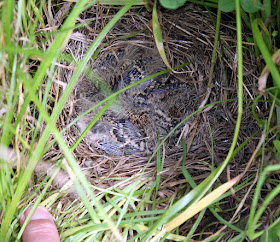The Summer Solstice proved to be a bit of a joke here in breezy Lancashire where May and June will surely prove to be the most miserable on record. I heard tell of folk reigniting their central heating this week during yet more days of wind, rain, cool temperatures and endless grey skies. My only contact with birds this week was a dash to Pilling on Thursday morning during a brief spell of dry and when I ringed a brood of 3 Skylark chicks. Otherwise my notebook stayed shut, so apologies to regular readers who looked in to find no new posts. There weren’t any.
With their downy fluff the Skylark chicks were well insulated against the weather and camouflaged from overhead predators. Was it chance that a flat stone immediately behind the nest gave protection from the prevailing westerly winds while providing a marker to the adult birds? I think not.
Skylark nest
Sunday morning was marginally better and at least dry although with a temperature of 12⁰C and a stiff breeze it was hardly summery. Undeterred I set off for Conder Green where there’s always something to see together with a chance of the unexpected. True to form and following more than a little perseverance the old notebook looked reasonable enough.
Redshanks in the creeks numbered 60+ with amongst them 2 returnee Common Sandpipers, a single Curlew, a couple of Pied Wagtails plus the obligatory Grey Heron and 2 Little Egrets. Two Common Terns continue to frequent the island.
Birder Lore says that thinking of or talking about a species is bound to jinx it in some way and most likely will mean the species never appears. But no sooner had I thought about when the regular but generally autumnal Kingfisher might appear than one flew across the creek. The Kingfisher sat up on a piece of tide washed tree and then promptly disappeared into the shelter of a sandy bank where it remained out of sight. It was good while it lasted as a Kingfisher is one of those species which can turn an ordinary day into one that is better than average.
Kingfisher
There are two pairs of adult Oystercatchers each with a single chick while a number of other adults continue to display and chase around without any signs of youngsters. Shelduck numbers are steady at a dozen or so and Tufted Duck less than ten but no signs of any youngsters.
Oystercatchers
Oystercatcher
Along the hedgerow and about the marsh I counted 8+ Greenfinch, a small number of Linnets & Goldfinch plus 3 Stock Dove.
Linnet
Along the railway path a Lesser Whitethroat was in full and loud song, a sign that at this stage of the season it may be singing for a second shot at breeding.
I made off for Pilling where there was unfinished business by way of another Skylark nest I’d failed to locate on Thursday - one where adults were feeding smallish young. The 6+ pairs of Skylarks here have small territories which makes it
quite difficult sorting out who is who and where each pair belong. I pin-pointed the nest in Hi-Fly’s field margins and close to a potato crop, the nest with three good sized chicks and just 50 yards from the earlier one out on the marsh.
Another Skylark nest
Skylark chick
In the picture above the chick’s egg tooth is still visible. The egg tooth is an essential component to the hatching process in almost all species of birds. Whereas most mammals maintain a protected internal environment for the growing foetus, birds use an external protective covering consisting of calcium which makes up the shell. This protective shell provides an isolated environment to allow the developing chick to thrive, but once the chick is ready to enter the outside world this secure cell has to be opened. The chick breaks open the shell by using its own internal clock in knowing when to emerge and while its beak and claws are not yet strong or sharp enough to break the shell, the egg tooth is able to penetrate the shell.
The marsh and ditches were quiet except 2 Little Egrets, 2 singing Whitethroat, a Reed Bunting and 10 or 12 Linnet. In the wood there was a Blackcap in full song and then along the hedgerow a pair of Whitethroats at a nest in the early stages of construction.
Yes, a good morning's birding.
Please log in next week for more birds and news with Another Bird Blog.
In the meantime this post is linking to Stewart's World Bird Wednesday.
In the meantime this post is linking to Stewart's World Bird Wednesday.







handsome linnet! oystercatchers are always beautiful. the kingfisher takes the prize, though!
ReplyDeleteIt is great seeing the Skylark chicks, I hope they continue to do well. The Kingfisher is awesome and I love the Oystercatchers! Great post, happy birding!
ReplyDeleteBeautiful series, Phil, and the linnet is adorable! :)
ReplyDeleteSo, nice to see these feathery beauties:)
ReplyDeleteLoved seeing the Skylark chick Phil and that iis a cracking shots of the Kingfisher.
ReplyDeleteSuch lovely birds and that kingfisher is icing on cake.
ReplyDeleteEnjoyed the views of the skylark's nest and chicks.
ReplyDeleteVisiting today from Our World...
ReplyDeleteLoved the nest finds...aren't they precious?!!!
And the favorite would have to be the babies AND the kingfisher...an even steven call on those two.
Cold temps? We have the grey skies and the miserable wet...but my goodness I'd give my two ovaries for some COLD 'bout now.
Any day with a kingfisher in it is a beautiful day for me too! The skylark chicks are very cute. Hope your weather gets warmer. I whinge when the overnight temps dip towards 12C!
ReplyDeleteLove the skylarks and the kingfisher is dazzling with his array of colors! Wonderful 'feathered friends' photography!
ReplyDeleteHappy Week to you,
artmusedog and carol
BEautiful birds, the skylark chick is precious!
ReplyDeleteExquisite capture of the Kingfisher, Phil. It is stunning! Such wonderfully rich colouring. Thank you for sharing.
ReplyDeleteEvery birding day is made so much better when a Kingfisher turns up. Great shot Phil. The Skylarks look to be doing well too. Weather has been the same here in Cheshire. Abysmal.
ReplyDeleteThe kingfisher is a really beautiful bird. - Margy
ReplyDeleteI so admire your fantastic pictures! To get a kingfisher so perfect is amazing. i saw a black and white kingfisher while travelling - did not even know that they exist!
ReplyDeleteLe Martin pêcheur est une pure merveille ;-)
ReplyDeleteCéline & Philippe
Interesting post on birds I don't know.
ReplyDeleteLovely shot of the Kingfisher, Phil.
ReplyDeleteAndy's right, that chick seems to be saying, "UNHAND ME!, you cad!!"
~
Such cute skylark chicks! And the Kingfisher is beautiful. Nice post!
ReplyDeleteLinnet, hmm I do not remember seeing one before, maybe, maybe not, but yours is delightful. Sorry about your soggy and cold weather. We have had a lot of rain, but hot and very humid. The sweet little Sky Larks are so fluffy and lovely. I hope the little ones grow and flourish soon. Have a wonderful remainder to your week, and true, a capture like your Kingfisher has to make it all better~
ReplyDeleteReally interesting post, Phil. Sorry to be a little late catching up to your blog, but given the frequency of the Peregrine watch and a few other things I had to take care of, I really haven't had a whole lot of time recently. I have been reading quite a bit in preparation for my upcoming visit to the UK and I have been surprised to find the implausible spots Oystercatchers sometimes choose for nests. Perhaps I'll get lucky and discover one for myself.
ReplyDelete